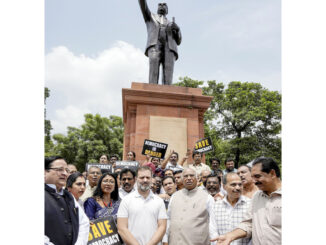

A few months before Operation Blue Star in 1984, thousands of farmers made Chandigarh their temporary abode and raised Kisan Nagar. Farmers had set up their kitchens and also set aside places for morning and evening prayers, besides enjoying performances by folk singers and theatre artistes during their free time.
Not many would know that Chandigarh once had a vibrant Kisan Nagar. Adjoining Punjab Raj Bhavan and spread along the Chandigarh Golf Club, it had kothis of eminent leaders, some of whom are now spearheading the farmers’ agitation. Besides nameplates and wooden television antennas, each kothi was designed in compliance with green and environment-friendly architecture. Interestingly, Kisan Nagar had come up yards away from the then center of power, Punjab Raj Bhavan. Though militancy was at its peak, it was the writ of farmers that ran over Kisan Nagar and its adjoining areas. Punjab was under President’s rule and the administration was under the control of the then Governor, BD Pande. He had a team of advisers to assist him.
At that time, the Chandigarh Administration was headed by K Banerjee, Chief Commissioner. Raghbir Singh, RK Niyogi and TC Gupta were the DC, SSP and SDM, respectively. The BKU was then headed by Bhupinder Singh Mann and had, among others, Ajmer Singh Lakhowal, Balbir Singh Rajewal and Ajaib Singh Khaira.
A few months before Operation Blue Star, thousands of farmers made Chandigarh their temporary abode and raised Kisan Nagar. So strong was the week-long siege that the Governor could manage to sneak out once, that too in disguise. Starting on March 12, 1984, Punjab farmers, under the banner of Bhartiya Kisan Union — at that time, it was the only unified body of farmers — laid siege to Raj Bhavan to demand the withdrawal of a hike in power tariff. It was the culmination of a 14-month-long peaceful agitation in various parts of the state. The siege ended on March 18, when most demands of the ‘special guests of the city’ were conceded.
Barring the numbers, venue and dates, there were numerous similarities between the 1984 and the 2020 agitations by the farmers.
It was a new experience for the City Beautiful and its residents. The farmers had set up their kitchens and also set aside places for morning and evening prayers, besides enjoying performances by folk singers and theatre artistes during their free time. At the end, when the farmers decided to lift the siege, they left behind huge stocks of foodgrains, vegetables, fruits, fuel and other items for use by residents in general, and the weaker sections in particular.
Interestingly, after the initial hostilities, especially from the residents of posh sectors, the farmers had managed to win the hearts and support of their new, though temporary, city mates. Thirty-six years later, this change of heart is reflected by the all-out support to the farmers during the current agitation.
(The author is a senior journalist. He is executive editor with PTC TV. He can be reached at prabhjot416@gmail.com)





Be the first to comment